Brancaster Chronicle No. 25: John Bunker Collages
Tarantula, 2015. 170X270cm, mixed media collage.
15th August 2015, London.
Those present: John Bunker, Anne Smart, Anthony Smart, John Pollard, Alexandra Harley, Nick Moore, Robin Greenwood, Sarah Greenwood, Hilde Skilton, Mark Skilton, Noela James, Patrick Jones, Ben Wiedel-Kaufmann, Matthew Dennis, Andrew Revell, Bob Aldous, Fred Pollock.
Starling, 2015, 54.5X37cm, mixed media collage.
Jackdaw, 2015, 91X71cm, mixed media collage.
Stingray, 2015, 103X91cm, mIxed media shaped collage.
Knave, 2015, 47X45.5cm, mixed media collage.
Clinch, 2015, 17.5X22cm, mixed media collage.
Houndsditch, 2015, 20.5X25.5cm, mixed media collage.
Tinderbox, 2015, 20.5X40.5cm, mixed media collage.
Widow’s Son, 2015, 22X27.5cm, mixed media collage.
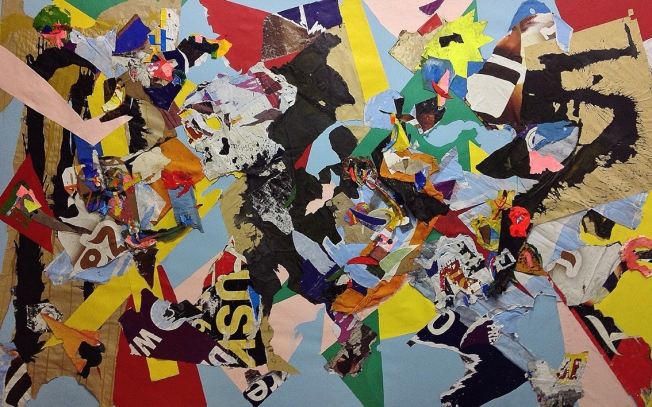

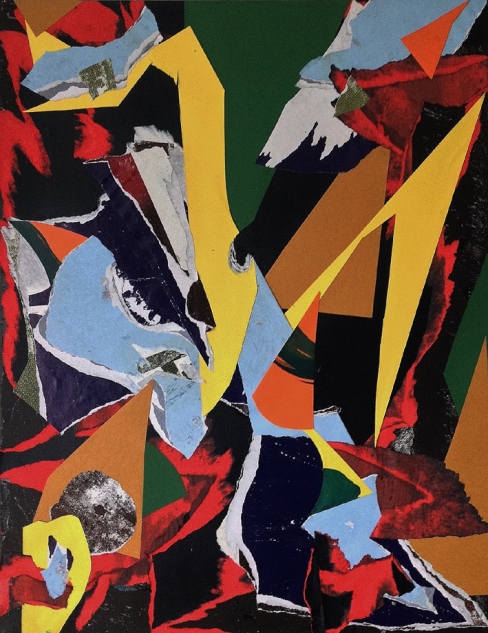
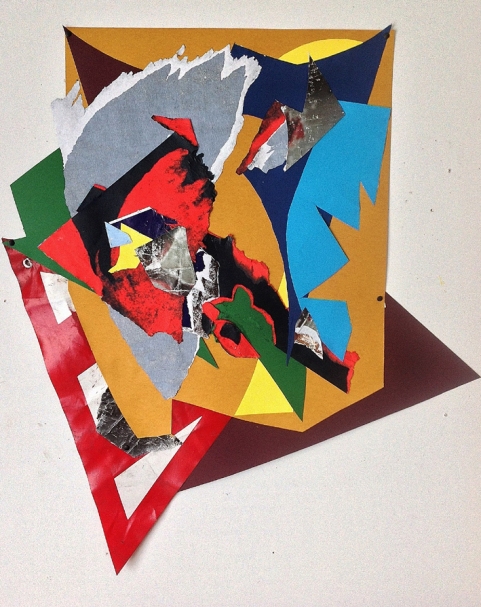

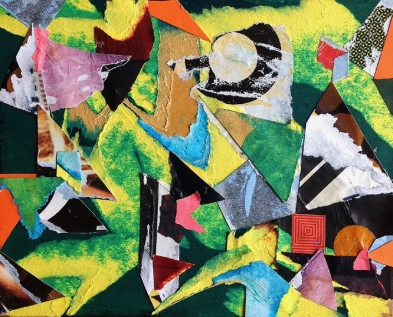

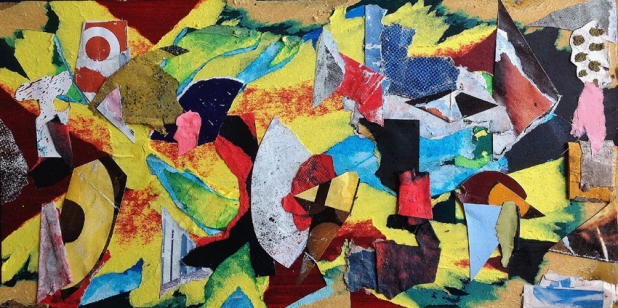
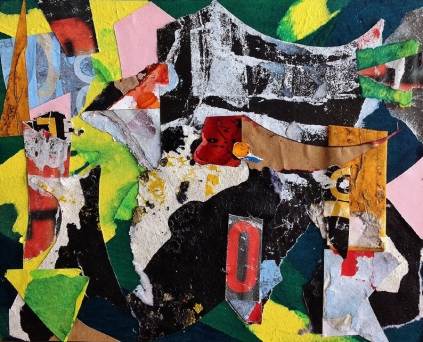
Very interesting thoughts about collage/assemblage/painting. In light of those thoughts and John’s recent comment at Abcrit about David Sweet’s Palaces Pollock and Pixar, I’m wondering: did anybody see the Thomas Hirschhorn show In Between at the South London Gallery earlier this fall? Any thoughts about that show? Is it in any way related to John’s work?
I didn’t see that Hirschhorn show, but Hirschhorn has shown a lot in New York. He’s a really nice guy—thinks good thoughts—but I can’t quite accept him as a sculptor. Looking at him through John’s work I can almost see Hirschhorn as a collage maker—but his work resists that too.
I think I remember some English critics seeing or almost seeing some Caro in the South London Gallery show. Maybe—but—(it’s interesting to me at least)—not the way you might see, say, Matisse in Motherwell (I just got hold of Sam Cornish’s terrific (as usual) little book on Motherwell’s drawings). Maybe I’m asking, is Hirschhorn “abstract”? Is he getting more—or less—“abstract”? John, can you “swallow” the guy?
LikeLike
You must be foucault joking…
LikeLike
I NEVER joke about sculpture, painting, drawing—even collage!
Robin, we’re old men—maybe too old, too conservative, too reactionary, too psychotic to understand Thomas Hirschhorn’s work. Maybe young people can help us.
I’ve tried pretty hard with Hirschhorn. When the Gramsci Monument was up, I visited it a number of times. I went to the art school classes Hirschhorn ran on Fridays 3 or 4 times. He insisted on students making “judgments” about art work. A good thought (I think). But the only criterion he allowed was: energy: yes—quality: no. Students would make work in the class or bring it in from home. The class would judge the work—would vote on it essentially. As I say, I think judging work is a good idea, a good thought. (It’s what you do at Brancaster.) Hirschhorn has good thoughts, but then he also seems to need to cut off “thinking.” (You “think” at Brancaster. John seems to “think” about every move he makes.)
John has talked about the political content in the materials he uses. There’s political content in Hirschhorn’s materials. Mark brought up the “real” space John engages in some of his collages. Not a lot of illusion in Hirschhorn’s work. . .
LikeLike
Maybe there are some generational changes in focus to consider here. Robin might have a a bit of an oedipal thing happening with Caro but my own generational hang -up is with the trajectory that runs minimalist turned conceptual turns ‘institutional critique’ turns ‘installation art’. Hirschhorn is someone I have been aware of for a good while. I also admire his energy, his hands on- get dirty approach to his interventionist contingent architectures that by turns celebrate and critique different visual cultures that bubble up all around us (‘judgement’ is very interesting in this context). I think most of its appeal boils down to his very physical and ingenious use of everyday materials to create these culturally dialogical inbetween spaces. I find it much more exhilerating than the rather pious and puritan works of minimalist come institutional critique pioneer Hans Haacke for instance, or the slicker contemporary purveyors of what might be termed ‘subjective anthropology’ of the likes of Liam Gillick or Mark Leckey.
But I’ve decided to turn away from that and back to the picture plane- but taking with me the dynamic oppositional qualities that can be found in the materials I use that make up the very fabric of my experiences. I started to find exciting tensions between texture/colour/shape- a sort of dynamo of very ‘formal’ possibilities but suggesting a sense of movement and sensation- a way of catching form in a constant state of becoming. These qualities of sensation echo with how I attempt to apprehend the world in all its complex political machinations both inner and outer. Hopefully I’m finding a different kind of space that happens best for me (and can be shared with others) on the picture plane…. At the moment.
LikeLike
Thanks for the comment, John. You kind of grew up with Hirschhorn and talk about turning away from him/his work. I didn’t grow up with Hirschhorn’s work. For me it’s an effort to turn toward it, but an effort not without rewards. Hirschhorn is a nice guy—nice in the ordinary sense (friendly/maybe empty/maybe riotously full), also in the sense that he’s hyper-ethically-conscious. Maybe he’s just hyper-self-conscious. I end up asking, is he a sculptor or some kind of (energetic) barbarian? I want to turn away, but I wonder am I then turning toward some kind of dream world.
There’s lots about Hirschhorn that’s just part of the world we live in though—lots that you can’t really turn away from. The “barbarism” mainly. But there are interesting little “things” too. Sam Cornish brought up the word “excessive” during Mark Skilton’s Brancaster session. Everybody talks about Hirschhorn’s excessiveness. Caro could be excessive. Maybe Caro was good when he was economical (not excessive), bad when he was excessive. Maybe Mark’s economically excessive: there’s no baloney. (Maybe Robin Greenwood is excessive in roughly the same (no baloney) way. Maybe Anthony Smart is too—in the way Mallarme was excessive.) It’s hard to say whether Hirschhorn’s excessiveness is good or bad. It probably doesn’t matter. What about you, John? Is your work “excessive”? Is there not something inherently excessive about collage? Schwitters was kind of straightforwardly excessive. You’re coming “late” to this excessiveness business. I find it kind of interesting that I kind of see some Hirschhorn, some “barbarism,” in those blue patches in Tarantula—interesting in that the blue patches are kind of empty: the “excessiveness” (it’s beautiful/“economical” excessiveness) is in the other “half” of Tarantula—“dynamic oppositional qualities” found in your materials??? I do get a big kick out of looking at what I can see of your work on my computer. It looks familiar at first—but the more you look, the more there is to see. . .
LikeLike
It seems to me the unbridgeable distance between John’s work and Hirschhorn’s, which makes the comparison pointless, is that John is a visual artist and Hirschhorn is a conceptual artist, in the line of Duchamp and Beuys. “Excessiveness” cannot be a positive attribute in visual art, because it means “too much”; it has to be a serious criticism, if it’s true.
That said, I find it slightly deflating that John seems to be defining himself as a formalist, concerned with the picture plane. I’m sure there is a lot more to him and his work than that.
LikeLike
Nic Carone, a devoted student of Hans Hofmann’s, a terrific teacher (at the New York Studio School!), a terrific artist, a master of the picture plane (!) (https://www.google.com/search?q=nicolas+carone&rlz=1C1ARAA_enUS517US517&espv=2&biw=1024&bih=679&tbm=isch&tbo=u&source=univ&sa=X&ved=0ahUKEwjytLqQntLJAhXDGz4KHeBHBHQQiR4IdA)—Nic was a friend of Marcel Duchamp’s. Nic was very proud of this friendship. Just the mention of Duchamp’s name, of course, shocked innocent Studio School students. Nic passed along “tricks” he’d learned from Duchamp: playing with string to start a painting or sculpture, for example. The Studio School survived this tentative/limited engagement with Duchamp. I think it’s a much richer place because of it.
John’s work is very different from Hirschhorn’s, but I don’t think there’s anything necessarily unbridgeable about the difference. Hirschhorn swiped some visual vitality from Schwitters. No reason John might not swipe some conceptual vitality from Hirschhorn. Am I hopelessly naïve/optimistic?
I want to stick with “excessiveness” as a (potentially) positive attribute in visual art—and any other kind of art. “Extravagant” is not a terrible alternative, but it leaves out the “too much-ness”—and there’s a sense in which “too much-ness” is a positive negative today. I think Hirschhorn’s excessiveness is kind of lazy now, just filled in. But your sculpture, Robin—(and Mark’s, as Sam says)—is excessive in a good way. Alan Gouk’s paintings are excessive. They’re too big, too full of color, too full of life. I’ve heard Bruce Gagnier is working on an excessively fat male figure now. James Joyce was excessive. Emily Dickinson was. Dusan Makavejev’s Sweet Movie is excessive. Stanley Cavell’s essay on Makavejev and Bergman is excessive. All this stuff is defiantly too much for an art fair—defiantly too much for Hell, Hull, and Hauser and Wirth—and that’s fine with me.
And I might just note that I rejoice at John’s mention of the picture plane. But here we return to the form/formalism vs. content business. We keep returning to the form/ formalism vs. content business. . .
LikeLike
very nice
LikeLike